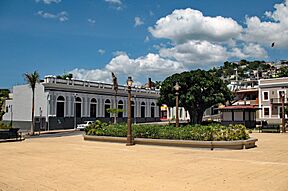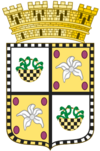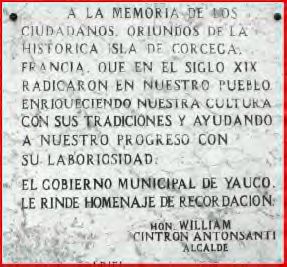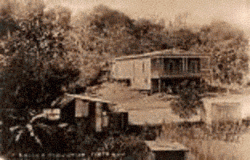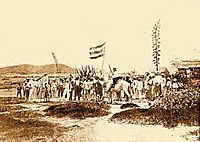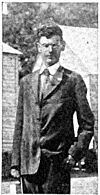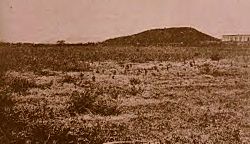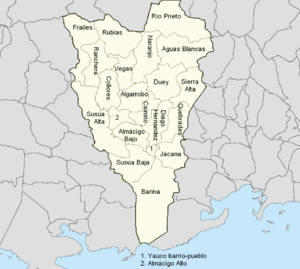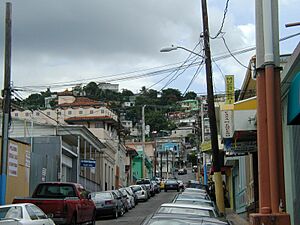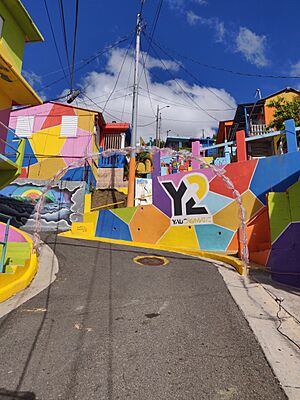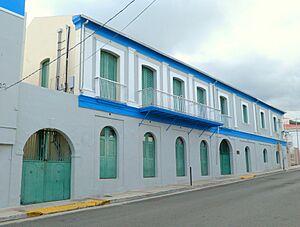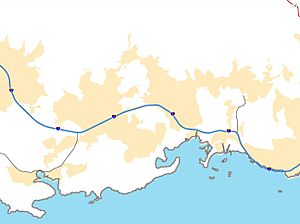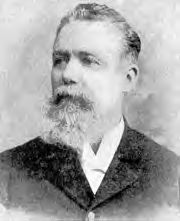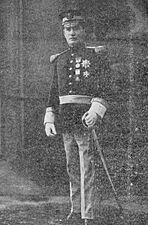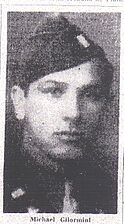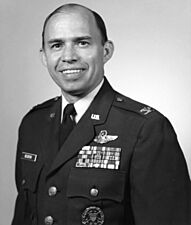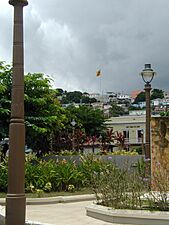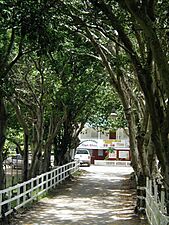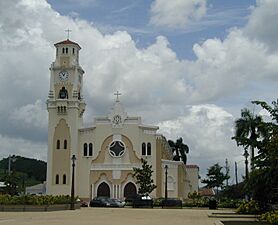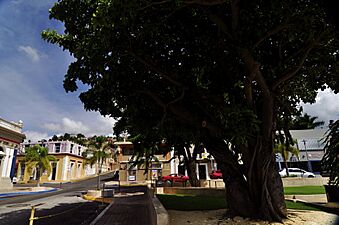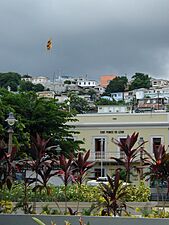Yauco, Puerto Rico facts for kids
Quick facts for kids
Yauco
Municipio Autónomo de Yauco
|
|||
|---|---|---|---|
|
From top, left to right: Fernando Pacheco Square; Teatro Ideal; Nuestra Señora del Rosario Church; and Casona Césari in Yauco Pueblo
|
|||
|
|||
| Nicknames: | |||
| Anthem: "Pueblo de gestas gloriosas" | |||

Map of Puerto Rico highlighting Yauco Municipality
|
|||
| Sovereign state | |||
| Commonwealth | |||
| Founded | February 29, 1756 | ||
| Barrios | |||
| Area | |||
| • Municipality | 68.8 sq mi (178.1 km2) | ||
| • Land | 68.1 sq mi (176.5 km2) | ||
| • Water | 0.6 sq mi (1.6 km2) | ||
| Population | |||
| • Municipality | 34,172 | ||
| • Rank | 36th in Puerto Rico | ||
| • Density | 496.94/sq mi (191.87/km2) | ||
| • Metro | 86,142 | ||
| Demonym(s) | Yaucanos | ||
| Time zone | UTC-4 (AST) | ||
| ZIP Code |
00698
|
||
| Area code(s) | 787/939 | ||
| Major routes | |||
Yauco is a town and municipality in southern Puerto Rico. It's located inland but reaches the Caribbean Sea coast. Yauco is surrounded by other towns like Maricao, Lares, Adjuntas, Sabana Grande, Guánica, and Guayanilla.
The municipality includes 20 smaller areas called barrios, plus Yauco Pueblo, which is the main downtown area. Yauco is an important town in the larger Yauco Metropolitan Statistical Area.
Yauco was founded on February 29, 1756, by Fernando Pacheco. It became known for growing crops like tobacco, sugar cane, and coffee. In the 1800s, many people from Corsica moved to Yauco. They liked the area because it was similar to their homeland. These Corsican immigrants greatly helped Yauco's coffee industry. This is why Yauco is often called El Pueblo del Café (The Coffee Town). Its residents are sometimes called Los Corsos (The Corsicans).
Contents
What's in a Name?
The name Yauco comes from the Yauco River. The river's name comes from the Taíno word coayuco. This word means "cassava plantation." Cassava is a root vegetable, also known as yucca.
Yauco has several fun nicknames:
- Pueblo del Café ("Coffee Town"): This is because of the many coffee farms in the area.
- Pueblo de los Corsos ("Town of Corsicans"): This nickname honors the large number of Corsican immigrants who settled here. They helped build the coffee industry.
- La Capital Taína ("the Taíno Capital"): This name remembers the native Taíno people of Puerto Rico who lived in this area long ago.
Yauco's Past
Early Taíno History
The Taíno people, who were the native inhabitants of Puerto Rico, believed the Yauco area was the capital of their island, Boriken. It was ruled by Agüeybaná, the most powerful Taíno chief, or cacique. All other chiefs followed Agüeybaná's lead.
After Agüeybaná died in 1510, his nephew, Güeybaná (also known as Agüeybaná II), became the main chief. He wondered if the Spanish newcomers were truly gods, as some believed. To find out, he and another chief, Urayoán, tested a Spaniard named Diego Salcedo. They tricked Salcedo into a river and drowned him. They watched his body to make sure he didn't come back to life.
When Salcedo didn't revive, Agüeybaná II and the Taíno realized the Spanish were not gods. They rebelled against the Spanish in 1511, but the Taíno were defeated.
Founding the Town
In 1755, Spanish settlers in the Yauco region built a small chapel. They named it Nuestra Señora del Santísimo Rosario (Our Lady of the Holy Rosary). The settlers then asked the Spanish Government to create a new town, since they had built a place of worship.
On February 29, 1756, the King of Spain agreed to their request. This is how the town of Yauco was officially founded. Fernando Pacheco, who represented the settlers, became the first leader of the new town.
Immigrants Arrive
From the mid-1800s to the early 1900s, many immigrants came to Puerto Rico. They came from places like Corsica, Italy, France, Portugal, Ireland, Scotland, and Germany. The Spanish Crown offered free land to Catholic European settlers, which attracted them. Most of these new settlers moved to the south-central part of the island.
Corsicans and Coffee
The island of Puerto Rico is quite similar in its mountains and land to Corsica. This made it an attractive place for many Corsican immigrants. Corsica was part of the Republic of Genoa for many years before becoming part of France in 1768.
Hundreds of Corsicans and their families started moving to Puerto Rico as early as 1830. Their numbers grew a lot in the 1850s. They were looking for new opportunities after problems in Europe. The Corsicans often settled in the mountainous southwestern part of Puerto Rico, and Yauco was a popular choice.
The main crops grown in Yauco were coffee, sugar cane, and tobacco. The new Corsican settlers first worked on farms. Many saved money to buy their own land or open grocery stores. They became very good at growing coffee.
Coffee was first grown in the Rancheras and Diego Hernández areas. It then spread to other areas like Aguas Blancas, Frailes, and Rubias. In the 1860s, the Mariani family changed a machine used for cotton to help process coffee beans. This made Puerto Rico's coffee look better and helped it become popular around the world. By the 1860s, Corsican settlers were leaders in Puerto Rico's coffee industry. Most coffee farms were owned by Corsicans.
The Yauco Uprising
Yauco was the site of the second and last major revolt against Spanish rule in Puerto Rico. This event is called the Intentona de Yauco (the attempted Coup of Yauco). It happened on March 26, 1897.
The revolt was planned by Antonio Mattei Lluberas, Mateo Mercado, and Fidel Vélez. They had support from leaders of an earlier independence attempt, El Grito de Lares. During this uprising, Fidel Vélez raised the flag that later became the current flag of Puerto Rico for the first time on the island. However, Spanish authorities had heard about the plan and quickly stopped the revolt.
Spanish–American War
In 1898, the Spanish–American War began. At that time, Guánica was a small part of Yauco. It had only 60 houses and was defended by a small group of Puerto Rican militia members. When American ships approached, the lighthouse keeper warned the residents. Most people left and went to Yauco to tell the mayor.
Only a few people stayed to greet the American soldiers. The first small fight happened there between the Puerto Rican militia and American sailors and Marines. The Americans fired back with a machine gun, and their ship, the Gloucester, also fired. The militia members were wounded and retreated to Yauco.
Yauco was also where the first major land battle in Puerto Rico took place during the war. On July 26, 1898, Spanish forces and Puerto Rican volunteers fought against American forces. This battle, known as the Battle of Yauco, happened at the Hacienda Desideria. The Spanish forces had some wounded and dead soldiers, and they were ordered to retreat.
Hurricane Maria's Impact
On September 20, 2017, Hurricane Maria brought a lot of rain to Yauco. This caused many landslides, which cut off entire communities. The Yauco River also flooded, damaging many neighborhoods.
Earthquakes in 2019 and 2020
Yauco was heavily affected by a series of earthquakes that started in December 2019. The strongest one, a 6.4-magnitude earthquake, hit on January 7, 2020. More than 32 homes collapsed, and hundreds of buildings were damaged.
To help the residents, the National Guard was called in. An emergency center was set up in the town's auditorium parking lot. It had tents for hospital patients who had to leave their rooms and food cooked by World Central Kitchen.
Yauco's Landscape
Yauco is a mountainous area located in the central mountain range. The Río Yauco flows through it. Other rivers in the municipality include the Río Chiquito, Duey Loco, and Río Naranjo.
Important hills in the area are Mount Membrillo, which is the highest point in Yauco and the 9th highest peak in Puerto Rico. It stands at 3,579 feet (1,090 meters) tall. Other peaks include the Rodadero Peak and Curet Hill.
Barrios of Yauco
Like all municipalities in Puerto Rico, Yauco is divided into smaller areas called barrios. The main town buildings, central square, and large Catholic church are in the barrio known as "el pueblo".
Here are the 21 barrios in Yauco:
Smaller Areas: Sectors
Barrios are further divided into even smaller areas called sectores (sectors). These can be different types of areas, like urbanizations or neighborhoods.
Population Changes
| Historical population | |||
|---|---|---|---|
| Census | Pop. | %± | |
| 1900 | 27,119 | — | |
| 1910 | 31,504 | 16.2% | |
| 1920 | 25,848 | −18.0% | |
| 1930 | 27,787 | 7.5% | |
| 1940 | 30,533 | 9.9% | |
| 1950 | 33,708 | 10.4% | |
| 1960 | 34,780 | 3.2% | |
| 1970 | 35,103 | 0.9% | |
| 1980 | 37,742 | 7.5% | |
| 1990 | 42,058 | 11.4% | |
| 2000 | 46,384 | 10.3% | |
| 2010 | 42,043 | −9.4% | |
| 2020 | 34,172 | −18.7% | |
| U.S. Decennial Census 1899 (shown as 1900) 1910–1930 1930-1950 1960–2000 2010 2020 |
|||
According to the United States Census Bureau, Yauco's population was 46,384 people in 2000. By 2010, it had decreased to 42,043 people. The 2020 census showed a further decrease to 34,172 people.
Fun Things to See and Do
After Hurricane Maria, artists in Yauco started a project called "Yaucromatic." They painted colorful murals on houses in Cerro de Yauco in Yauco barrio-pueblo. This helped lift spirits and make the town beautiful again.
There are two beaches in Yauco, including Playa Ballenas.
Places to Visit
Here are some interesting places in Yauco:
In Yauco Pueblo (the historic downtown):
- Cesari House: A historic house built in 1893.
- Chalet Amill: A beautiful house from 1914.
- Filardi House: Another historic house from 1916.
- Franceschi Antongiorgi House: A house built in 1907.
- González Vivaldi House: A house from 1880.
- Logia Masónica Hijos de la Luz: A historic masonic lodge from 1894.
- Negroni Mansion: Also known as the Agostini House.
- Nuestra Señora del Rosario Church and City Hall: Located at Plaza Fernando Pacheco.
- Nuestra Señora del Rosario Hermitage Ruins: An old hermitage, now a museum and ruins.
- Santísimo Rosario School: A school in a historic building.
- Teatro Ideal: A historic theater that opened on April 24, 1920.
- Yaucromatic painted houses and murals: The colorful art project.
Other places in Yauco:
- Apiturismo: A honey farm where you can learn about beekeeping.
- Atolladora Beach: A beach shared with Guayanilla.
- Guilarte State Forest: A forest shared with other towns.
- Hacienda Mireia: Also called Hacienda La Juanita, a historic coffee farm.
- Lake Luchetti: A reservoir and wildlife refuge.
- Mario "Ñato" Ramírez Torres Municipal Stadium: A sports stadium.
- Mount Membrillo: The highest mountain in Yauco.
- Pico Rodadero: The second highest mountain in Yauco.
- Raúl "Pipote" Oliveras Vera Coliseum: Another sports arena.
- Susúa State Forest: A forest shared with Sabana Grande.
- Tozza Castle: A replica of a small castle in Corsica.
- Volkyland Museum: A museum dedicated to the Volkswagen Beetle car.
The Puerto Rico Tourism Company has a campaign called Voy Turistiendo ("I'm Touring"). It highlights places like the Yaucromatic murals, the view from Pico Rodadero, the Luchetti Reservoir wildlife refuge, and the Apiturismo honey farm.
Yauco's Economy
Yauco's main crops are coffee, plantains, oranges, and tobacco. Yauco coffees are known for their rich flavor. In the 1800s, Yauco coffee was sold in faraway places like Europe. Other coffee producers even tried to say their coffee came from Yauco because it was so famous. Cafe Yaucono is a well-known Puerto Rican coffee brand named after the town.
Yauco also makes textiles (fabrics) and other light manufactured goods. The company Sartorius pharmaceuticals expanded its operations in Yauco in 2019.
Culture and Traditions
Festivals and Events
Yauco celebrates its patron saint festival in October. This festival, called Fiestas Patronales de Nuestra Virgen del Rosario, is a religious and cultural event. It usually includes parades, games, local crafts, rides, traditional food, and live music.
Other festivals and events in Yauco include:
- Coffee Festival – February
- Christmas Festival - December
- Festival Internacional de las Culturas (International Cultures Festival) – December
Cultural Influences
Over time, many different cultures have influenced Yauco. People from Portugal, Spain, Native American groups, Corsica, Ireland, Scotland, Germany, Italy, North Africa, West Africa, and European Jewish communities have all contributed to the local culture. These influences can be seen in the food, art, language, customs, beliefs, and music of Yauco.
Getting Around Yauco
The main road that goes through Yauco is PRI-2. This road is part of the US Interstate Highway System, which means it gets a lot of funding from the U.S. government.
In 2019, Yauco had 40 bridges. Some bridges were damaged during Hurricane Maria in 2017. A bridge carrying PR-359 also needed to be torn down because of damage from the 2019–2020 Puerto Rico earthquakes.
Yauco's Symbols
The municipio of Yauco has its own official flag and coat of arms.
The Flag
The flag of Yauco has two equal horizontal stripes. The top stripe is black, and the bottom stripe is gold. The municipal coat of arms is placed in the center of the flag.
The Coat of Arms
The coat of arms of Yauco is divided into four sections by a central cross. This cross represents Christendom.
- In the first section, there's a gold and black boiler with seven black serpent heads.
- The second and third sections show two coffee plant flowers with silver leaves and red parts. These flowers and coffee beans represent the importance of coffee growing in Yauco.
- The border around the shield looks like the beads of a rosary.
- The crown with four towers on top shows that Yauco is a town.
Famous People from Yauco
Many notable people were born in Yauco, including:
- Elmer Román (born 1972) – A former Secretary of State of Puerto Rico.
- Johnny Albino (1919–2011) – A famous singer.
- Benny Ayala (born 1951) – A baseball player who won the World Series in 1983 with the Baltimore Orioles.
- Mihiel Gilormini (1918–1988) – An airman from World War II who founded the Puerto Rico Air National Guard.
- Antonio Mattei Lluberas (1857–1908) – A leader of the Intentona de Yauco revolt.
- Héctor Andrés Negroni (born 1938) – The first Puerto Rican to graduate from the United States Air Force Academy.
- Mike Perez (born 1964) – A Major League Baseball pitcher in the 1990s.
Images for kids
See also
 In Spanish: Yauco para niños
In Spanish: Yauco para niños


